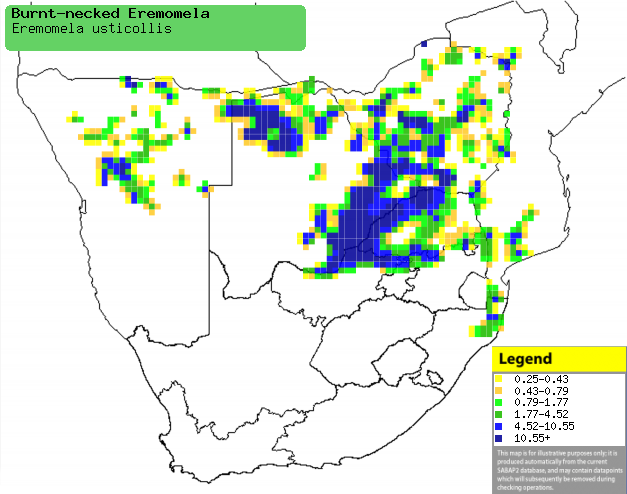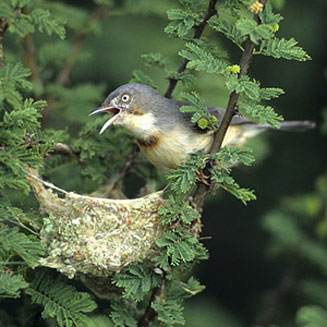|
Eremomela usticollis
(Burnt-necked eremomela)
Bruinkeelbossanger [Afrikaans]; Niini (generic term for
warblers and eremomelas) [Kwangali]; Timba (generic name for cisticolas
and warblers) [Shona]; Roesthals-eremomela [Dutch]; Érémomèle à cou
roux [French]; Rostkehl-eremomela, Rostband-eremomela [German];
Eremomela-de-garganta-castanha [Portuguese]
Life
> Eukaryotes >
Opisthokonta
> Metazoa (animals) >
Bilateria >
Deuterostomia > Chordata >
Craniata > Vertebrata (vertebrates) > Gnathostomata (jawed
vertebrates) > Teleostomi (teleost fish) > Osteichthyes (bony fish) > Class:
Sarcopterygii (lobe-finned
fish) > Stegocephalia (terrestrial
vertebrates) > Tetrapoda
(four-legged vertebrates) > Reptiliomorpha > Amniota >
Reptilia (reptiles) >
Romeriida > Diapsida > Archosauromorpha > Archosauria >
Dinosauria
(dinosaurs) > Saurischia > Theropoda (bipedal predatory dinosaurs) >
Coelurosauria > Maniraptora > Aves
(birds) >
Order: Passeriformes > Family: Sylviidae
> Genus: Eromomela
Distribution and habitat
Occurs from Zambia to Malawi south to southern Africa. Here
it is fairly common in fine-leaved Acacia woodland, rarely moving into
gardens with Acacia trees and broad-leaved woodland.
|
 |
|
Distribution of Burnt-necked eremomela in southern
Africa, based on statistical smoothing of the records from first SA Bird
Atlas Project (©
Animal Demography unit, University of
Cape Town; smoothing by Birgit Erni and Francesca Little). Colours range
from dark blue (most common) through to yellow (least common).
See here for the latest distribution
from the SABAP2. |
Food
Its diet is has not been well-studied, however it is known
to eat insects and their larvae, spiders and sometimes the nectar of the
Mountain aloe (Aloe marlothii). It often joins mixed species foraging
flocks along with other passerines, gleaning insects from leaves and branches in
the canopy.
Breeding
- The nest is a delicate cup built of soft plant down covered with dry
leaves or insect egg capsules. It is typically suspended from a few twigs in
the Acacia canopy.
 |
|
|
Burnt-necked eremomela at its nest, Sericea
farm, South Africa. [photo Warwick Tarboton ©] |
|
- Egg-laying season is from September-April, peaking from October-March.
- It lays 1-4 eggs, which are incubated by both sexes.
- The chicks are brooded and fed by both of their parents.
Threats
Not threatened.
References
-
Hockey PAR, Dean WRJ and Ryan PG 2005. Roberts
- Birds of southern Africa, VIIth ed. The Trustees of the John Voelcker
Bird Book Fund, Cape Town.
-
Harrison, J.A., Allan, D.G., Underhill, L.G., Herremans, M.,
Tree. A.J., Parker, V. & Brown, C.J. (eds). 1997. The atlas of southern
African birds. Vol. 2: Passerines. BirdLife South Africa, Johannesburg.
|
